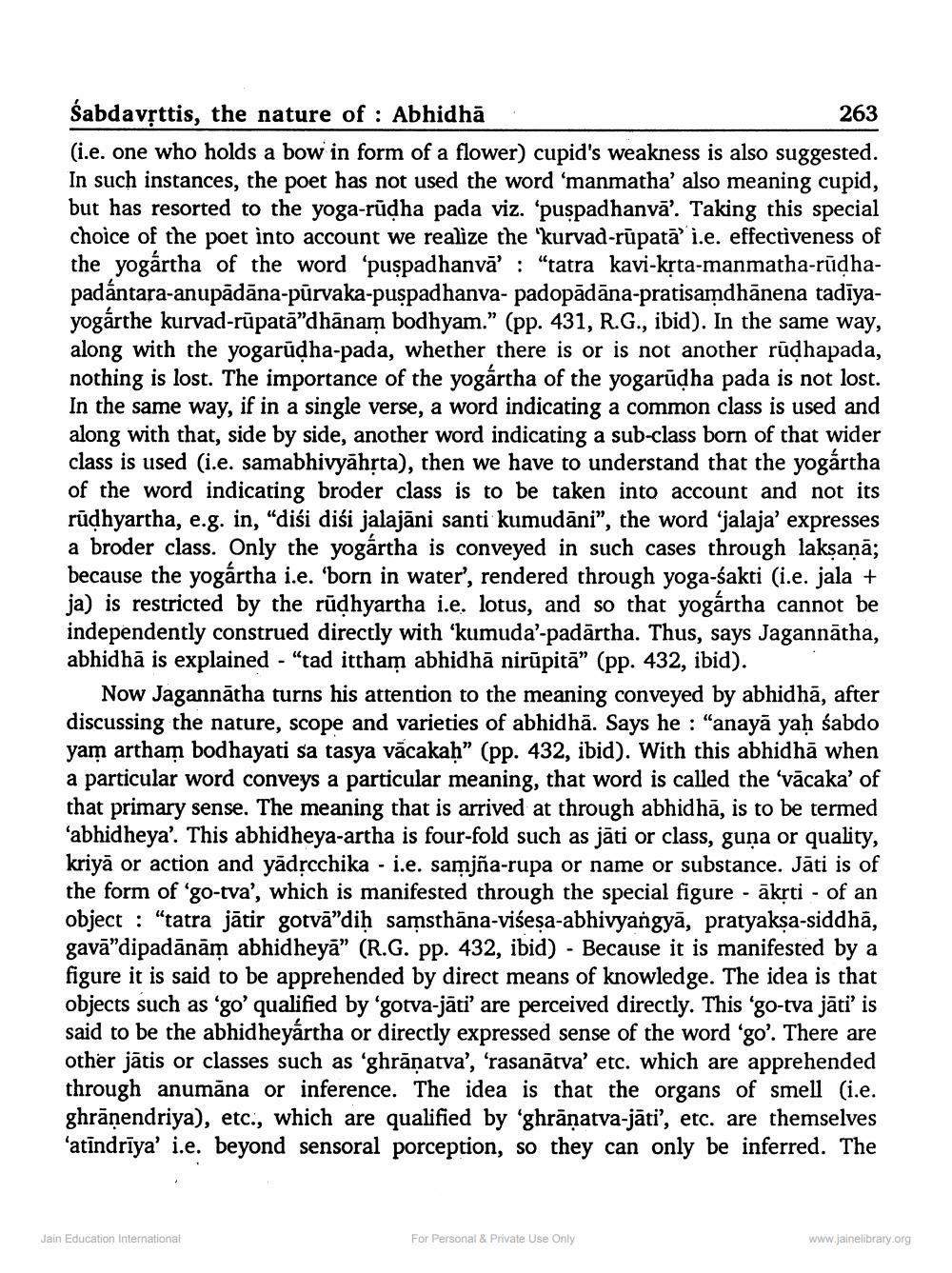________________
Śabdavșttis, the nature of : Abhidhā
263 (i.e. one who holds a bow in form of a flower) cupid's weakness is also suggested. In such instances, the poet has not used the word 'manmatha' also meaning cupid, but has resorted to the yoga-rūdha pada viz. 'puspadhanvā'. Taking this special choice of the poet into account we realize the 'kurvad-rūpatā i.e. effectiveness of the yogártha of the word 'puspadhanvā' : "tatra kavi-kşta-manmatha-rūdhapadántara-anupādāna-pūrvaka-puspadhanva- padopādāna-pratisamdhanena tadiyayogárthe kurvad-rūpatā”dhānam bodhyam.” (pp. 431, R.G., ibid). In the same way, along with the yogarūdha-pada, whether there is or is not another rūdhapada, nothing is lost. The importance of the yogártha of the yogarūdha pad In the same way, if in a single verse, a word indicating a common class is used and along with that, side by side, another word indicating a sub-class born of that wider class is used (i.e. samabhivyāhrta), then we have to understand that the yogartha of the word indicating broder class is to be taken into account and not its rūdhyartha, e.g. in, "diśi disi jalajāni santi kumudāni”, the word 'jalaja' expresses a broder class. Only the yogártha is conveyed in such cases through laksanā; because the yogártha i.e. born in water', rendered through yoga-śakti (i.e. jala + ja) is restricted by the rūdhyartha i.e. lotus, and so that yogártha cannot be
dently construed directly with 'kumuda'-padārtha. Thus, says Jagannatha, abhidhā is explained - “tad ittham abhidhā nirūpitā” (pp. 432, ibid).
Now Jagannātha turns his attention to the meaning conveyed by abhidhā, after discussing the nature, scope and varieties of abhidhā. Says he : "anayā yah sabdo yam artham bodhayati sa tasya vācakah” (pp. 432, ibid). With this abhidhā when a particular word conveys a particular meaning, that word is called the 'vācaka' of that primary sense. The meaning that is arrived at through abhidhā, is to be termed 'abhidheya'. This abhidheya-artha is four-fold such as jāti or class, guņa or quality, kriyā or action and yādrechika - i.e. samiña-rupa or name or substance. Jāti is of the form of 'go-tva', which is manifested through the special figure - āksti - of an object : “tatra jātir gotvā"dih samsthāna-viśesa-abhivyangyā, pratyaksa-siddhā, gavā"dipadānām abhidheyā” (R.G. pp. 432, ibid) - Because it is manifested by a figure it is said to be apprehended by direct means of knowledge. The idea is that objects such as 'go' qualified by 'gotva-jāti' are perceived directly. This 'go-tva jāti' is said to be the abhidheyártha or directly expressed sense of the word 'go'. There are other jātis or classes such as 'ghrāņatva', 'rasanātva' etc. which are apprehended through anumana or inference. The idea is that the organs of smell (i.e. ghrāņendriya), etc., which are qualified by 'ghrāņatva-jāti', etc. are themselves 'atīndrīya' i.e. beyond sensoral porception, so they can only be inferred. The
Jain Education International
For Personal & Private Use Only
www.jainelibrary.org




